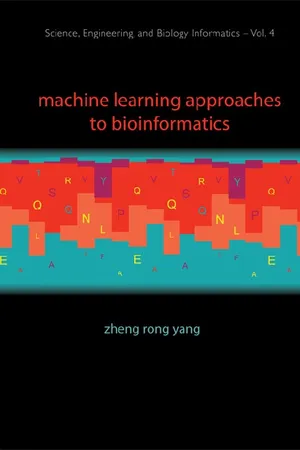
- 336 pages
- English
- PDF
- Available on iOS & Android
Machine Learning Approaches To Bioinformatics
About this book
This book covers a wide range of subjects in applying machine learning approaches for bioinformatics projects. The book succeeds on two key unique features. First, it introduces the most widely used machine learning approaches in bioinformatics and discusses, with evaluations from real case studies, how they are used in individual bioinformatics projects. Second, it introduces state-of-the-art bioinformatics research methods. The theoretical parts and the practical parts are well integrated for readers to follow the existing procedures in individual research.Unlike most of the bioinformatics books on the market, the content coverage is not limited to just one subject. A broad spectrum of relevant topics in bioinformatics including systematic data mining and computational systems biology researches are brought together in this book, thereby offering an efficient and convenient platform for teaching purposes.An essential reference for both final year undergraduates and graduate students in universities, as well as a comprehensive handbook for new researchers, this book will also serve as a practical guide for software development in relevant bioinformatics projects.
Frequently asked questions
- Essential is ideal for learners and professionals who enjoy exploring a wide range of subjects. Access the Essential Library with 800,000+ trusted titles and best-sellers across business, personal growth, and the humanities. Includes unlimited reading time and Standard Read Aloud voice.
- Complete: Perfect for advanced learners and researchers needing full, unrestricted access. Unlock 1.4M+ books across hundreds of subjects, including academic and specialized titles. The Complete Plan also includes advanced features like Premium Read Aloud and Research Assistant.
Please note we cannot support devices running on iOS 13 and Android 7 or earlier. Learn more about using the app.
Information
Table of contents
- Contents
- Preface
- 1 Introduction
- 2 Introduction to Unsupervised Learning
- 3 Probability Density Estimation Approaches
- 4 Dimension Reduction
- 5 Cluster Analysis
- 6 Self-organising Map
- 7 Introduction to Supervised Learning
- 8 Linear/Quadratic Discriminant Analysis and K-nearest Neighbour
- 9 Classification and Regression Trees, Random Forest Algorithm
- 10 Multi-layer Perceptron
- 11 Basis Function Approach and Vector Machines
- 12 Hidden Markov Model
- 13 Feature Selection
- 14 Feature Extraction (Biological Data Coding)
- 15 Sequence/Structural Bioinformatics Foundation – Peptide Classification
- 16 Gene Network – Causal Network and Bayesian Networks
- 17 S-Systems
- 18 Future Directions
- References
- Index